Chris Baty's Blog, page 227
October 29, 2012
NaNoWriMo Without Power

Given a certain weather system named Sandy encroaching upon a goodly number of our East Coast Wrimos, there’s a very real possibility that November will start for some of you without access to a computer, or nanowrimo.org, or access to modern light sources!
We asked the community of Wrimos over on Facebook what they suggest for participants writing without power, and we’ve compiled their replies here. (All in all, it sounds like this approach is far more romantic and way more fun than the way we’ve been doing it all these years…..)
Who needs a computer…
when you could write with a typewriter, AlphaSmart (amazingly long battery life), pens and notebooks (“ink and trees,” as one Wrimo put it), pencils and a manual sharpener, an iPad charged off the car (!!!), or use a hand-held voice recorder. One participant even claimed he had hand-sharpened, turkey-feather quills at the ready. If you are writing on paper, one Wrimo suggested storing your reams in a watertight bag in case of flooding.
Who needs lightbulbs…
when you could write by the light of a headlamp (Look, Ma! No hands!), strategically propped flashlight, candles, or a camping lantern. If you run low on batteries, use a hand-crank flashlight!
Who needs a plot…
when you could drop exciting elements like a hurricane, power outages, and candle-lit novel-writing into your novel. Talk about ready-made inspiration! If you do have a plot at the ready, your fellow writers suggest printing off your outline in advance or mapping your novel on note cards pinned to a corkboard for reference.
The upshot: Wrimos are an incredibly resourceful bunch, and always ready for anything! We’re all sending good, safe thoughts your way and rooting for your extra-exciting noveling experience.
— Lindsey
Photo by Flickr user jasleen_kaur
Rediscovering the Craft and Writing Despite Doubts

If any writer has sweep, it’s Lynn Viehl: a New York Times best-selling author, she’s written nearly 50 novels in eight different genres. This year, she’s asking her readers to help her to choose what to put on paper for NaNoWriMo, and will be posting her draft as she goes at her fiction blog.
She tells us about rediscovering her love for her craft, the perks of letting yourself be a little crazy, and writing the stories you want to during NaNoWriMo:
I adore NaNoWriMo. It’s exciting, it’s crazy, and it motivates more people to write than Saturday detention. Every year I support the madness via my blog by finding resources, encouraging those who commit, and otherwise behaving like a book-writing nag. This doesn’t endear me to the snobs, but I can make fun of them throughout November, which is a nice bonus.
Occasionally I also join in, as I did after finishing two novel series back in 2009. I love all my stories, but after a decade of writing medieval vampires, and SF surgeons I wanted to try something without fangs or scalpels. I settled on a story idea set in a nineteenth-century alternate universe, in which America loses the Revolutionary War and remains part of the British Empire. I could rewrite history and make my countrymen drink tea, wear fussy clothes and have exquisite manners while behaving badly. It would be like Masterpiece Theater on crack.
I mentioned my fabulous idea to some friends, who were nice enough to give me instant feedback:
“Sounds weird.”
“You’ll never sell that.”
“What about the vampires?”
“That world is impossible. Not to mention unpatriotic.”
“Tea? What happened to coffee? You can’t kill coffee.”
All their gloominess actually sealed the deal for me; I wouldn’t worry about selling it. I’d write simply for the joy of it, and what better time than with the rest of the planet during NaNoWriMo? When November 1 arrived I skipped into my office and went to work.
For the next thirty days I wrote like a maniac, and posted my stats and progress online. While my friends worried, my readers cheered me on. Once I hit the 50K mark I scared my dogs by shrieking and dancing before I went back to work. I could have stopped, but I was having too much fun. The magic on the page enchanted me so much it felt like the novel was writing itself. I had a blast, rediscovered my craft, fell in love with storytelling again, and finished NaNoWriMo 2009 with almost 60K.
The novel turned out so well that I went completely insane and decided to submit it. I sent it out to a dozen publishers, all of whom rejected it (several requested I send them some vampire fiction.) I kept at it, but after three years of rejections all my friends were saying “Told you so.”
I didn’t want to give up. I might have written the book on a lark, but it was some of my best work. Besides, the first novel I’d published was one I’d written for fun; it could happen again. I did get close to publication a couple of times. Once the novel went for approval to purchase, only to be vetoed by a senior editor. Another offer came in but didn’t survive contract negotiations.
So why should you try NaNoWriMo when an old pro like me couldn’t sell her NaNo novel? Well, this past summer my submission landed on the desk of the right editor, who loved it and made me an offer. Not only for the novel, but for a series—which makes me one of the rare writers to sell a novel series based on a NaNoWriMo book.
Writing a book in a month is madness, but a little crazy could be just what you need. I hope you’ll join me in November, offend the snobs, annoy your friends, and write something radical. It’ll be fun, and like me you may end up being the one to say “Told you so.”
Since her debut in 2000, New York Times bestselling author Lynn Viehl has published 47 novels in 8 genres, and is the host of Paperback Writer, a popular publishing industry weblog featuring writing advice, market info and free resources for writers. Find out more about Lynn at:
Her blog
Her fiction blog
Her photo blog
At Amazon
And you can read her 2009 NaNoWriMo posts here.
Photo of her journal by Lynn Viehl.
October 26, 2012
How to Write the "Impossible"

Michelle is a Wrimo of great, terrifying, admirable ambition. Writing 50,000 words in a month is a feat, doing it every month for a year is the stuff of legend. With nearly ten novels under her belt so far, she tells us what she’s learned about what makes for an enjoyable creative journey:
I began this year with a simple, terrifying goal: to write one novel every month for the whole of 2012. I wanted the rush of NaNoWriMo full time, to study what it is to write and keep writing. I wanted to dive into my own stories and not come up for air until 2013.
And, so far, I’ve done it. When NaNoWriMo starts, I will have written ten novels this year for a total of 500,000 words—and I won’t stop there. I have learned so much about writing, about starting, ending, and continuing through all odds. And while all novels are different, here are some lessons I’ve used to get me to the “The End” these past ten times:
Find a story that excites you. A good beginning can mean everything for the month ahead. While all novels can be finished, the story that gets your heart pounding and your brain whirring will carry you through. Hold out as long as you can for that feeling of anticipation, when the idea is just too good to let go of. It doesn’t matter what it is, as long as it makes you want to write.
Choose your traveling companion wisely. Your main character will be your primary social interaction for the rest of November. If they aren’t likable, I guarantee you will want to gouge out their eyes within 10,000 words. A good main character will get you through the hard parts; when the story is gone and all seems lost, they will be your salvation. Choose them with care.
Find a touchstone. Find something that connects you to the first rush of inspiration—a song, picture, memory, anything. When your plot drifts far out to sea, your touchstone is the north star. Use it to keep writing, to remind you of why you began, and to find your way back to shore.
Expect resistance. There will be times when all the tricks don’t work; when the writing prompts feel silly and your characters have left the scene. The hour is desperate, your hands might as well be nailed to the desk, and you want so very badly to give up. This is Resistance, the constant companion to any creative endeavor, and he only comes out when we are about to do something wonderful. Tell him “hi,” then dig in and keep writing—things are about to get good.
Above all, write for yourself. This novel is for you, it belongs to no one else. Write what you want, write when you want, write however you need. Writing rules are made by other people; break them, kill them, make a mess of finger paint and confetti on the walls of your imagination. This is supposed to be hard, messy, and sometimes life-altering, but make sure you love it. Because its yours.
You are ready, even if you don’t know it. This is your time, your chance, your story. Write it.
 Michelle Tuckett is a practicing word ninja living in her hometown of Salt Lake City, Utah. Her obsession with otherworldly things began at birth, when she was named after a random gravestone. She spends her time believing impossible things and chronicling her insights and tribulations from writing a novel every month for a year at 12novels.com.
Michelle Tuckett is a practicing word ninja living in her hometown of Salt Lake City, Utah. Her obsession with otherworldly things began at birth, when she was named after a random gravestone. She spends her time believing impossible things and chronicling her insights and tribulations from writing a novel every month for a year at 12novels.com.
Photo at top by Flickr user San Diego Shooter.
October 25, 2012
Ask NaNoWriMo

Dear Wrimos,
We are so close. NaNoWriMo 2012 is looming around the bend, and if you’re anything like me, your head is abuzz with questions. Will I win this year? What am I going to write about? What is the ideal way to mash potatoes during American Thanksgiving with one hand whilst typing on my laptop with the other?
The best thing about the NaNoWriMo community is that not only are you collectively good-looking and kind, you are wise beyond your years (whatever years those may be; tack on fifteen, and we officially declare that that is the age of your wisdom. Tada!).
The wisdom of the NaNoWrimo sages who’ve come before you is ready for your perusal in the “Reaching 50,000” forum. Distressed about the fact that NaNoWriMo seems hungry for your inner spirit? Commiserate at the “NaNoWriMo Ate My Soul” forum! We’ve got Wrimos who’ll be blogging for us about writing while parenting toddlers, writing while on a book tour, and writing while preparing for a marathon.
But we also know you have specific situations that are unique to you as November approaches. It’s why we’re throwing our folding chair over our shoulder, marching out to the side of the information superhighway, and setting up shop: Free NaNoWriMo Advice (Lemonade included, if you happen to be in Berkeley).
Every week, we’ll answer a few of your questions:
“Is it too late to outline?” you may be wondering.
“I know violence is never the answer, but really, is violence never the answer? What if it’s fictional violence against a soulless robot samurai lord whose only mission is to destroy me and everything I love? Also, he smells like liverwurst?”
“Can I really do this?”
Every week, your question may be answered by a denizen of NaNoLand. Your novel-whisperer/life coach/quipper could be the staff member best-suited (or, let’s be honest, with the most time), an ML or fellow Wrimo, or of course, Mr. Ian Woon, the Plot Bunny, the Traveling Shovel of Death, the Guilt Monkey, or Chris Baty himself. They all pass through at odd times, but even the TSoD has a layover nearby fairly often.
Shoot us a question here! We think it’d be nice to start with Dear NaNoWriMo, and end with Yours in writing, “PSEUDONYM-THAT-REFERS-TO-MY-QUANDARY-HERE”. But that’s just a suggestion. If you’d like to include your word count, and favorite mythical creature, well, that’s just icing.
Yours in writing,
Eagerly Anticipating Questions in Berkeley
0 Words
Loch Ness FTW
October 24, 2012
The ML's Guide to Writing in Edmonton: Literary Ninja-Style

Edmonton! The capital of Alberta, Canada, and home to one of the coolest, proudest, Wrimo-iest regions around. It’d have to be, wouldn’t it, since Sarah Mackey, NaNoWriMo’s Community Liaison hails from here, as does former intern and current ML Paige.
The Edmowrimos took some time to show you just how a literary ninja kicks some serious noveling tail. (And check out how LA, NYC, Atlanta, the Philippines, and London take on the writing madness, too!)
The Edmonton region rundown:
Best Local Writer Fuel — When you’re up typing away into the wee hours, sometimes you hit that 2:00 a.m. point where you’re starving but too involved in your novel to cook. Handily, if you’re near the Whyte Avenue area, Steel Wheels is there to save you.
It’s kind of like the Room of Requirement, really—you stumble across it just when you need it. Three dollars gets you two giant slices of delicious pizza, and the graffiti-covered wooden booths are great for overhearing bits of dialogue to slip into your novel.
Best Way to Beat Writer’s Block — The best teahouse in Edmonton is Steeps. The atmosphere is perfect for letting yourself sink into the words: low lighting, gorgeous art on the walls, mismatched tea cups that you to choose from, and old wooden tables. If you can brave the winter to go out, it’s a surefire fix for lack of inspiration.
If you don’t want to risk frostbite, though, there’s always the chatroom, a shining beacon of wordy gloriousness. Without fail, every night during the on-season, there will be between four and forty Wrimos hanging out online, running word-wars. Our chatroom is the home-away-from-home for Edmowrimos who have moved away, too. Once an Edmowrimo, always an Edmowrimo.
Regional Genre of Choice — We have a lot of fantasy authors in Edmonton. Notably, we also once had a Wrimo who was explaining his novel and suddenly realized he was writing Pac-Man fanfic.
The Can’t Miss Edmonton NaNo Event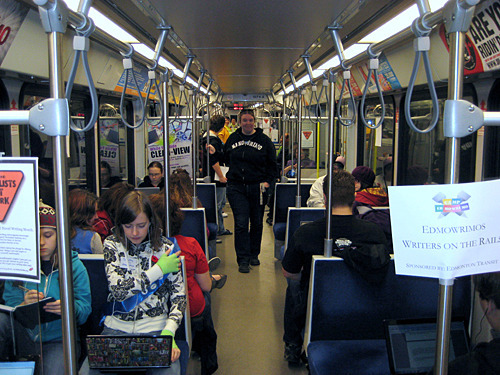
We’re planning a new event this year that we’re really excited about: (K)Night of the Living Spec. We’ve been invited to hold events during the Pure Speculation Festival, Edmonton’s annual celebration of science-fiction, literature, and media. We’ll be running a ten-hour write-in, re-animating previously killed-off characters, and running a word-war tournament (and more!) amongst panels, gaming, costumes, merchandise, vendors, and artwork.
The Runners-Up — ”Our overnighter! I find little else to be as magical as the strange phrases and unexpected plot twists that arise at 4:30 in the morning, sitting up with a bunch of equally sleep-deprived, coffee-buzzed Wrimos.” — Paige
“Pub Write. There is nothing like descending upon a poor hapless pub with an army of laptops, drinking until you fall on people (true story), and dancing when you need a break.” — Crystal
The Municipal Liaisons
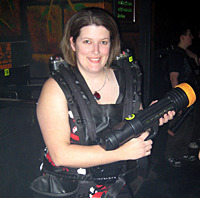 Karen (7th year ML, 10th year Wrimo): I was recruited to NaNoWriMo in 2003 by Sarah Mackey, and failed miserably for my first two years. I won on my third try and Sarah asked me to co-ML shortly after the end of November that year. I co-MLed with Sarah for four years, until she moved into the role of Community Liaison for the OLL. This is my seventh year as an ML, and I’m still loving it!
Karen (7th year ML, 10th year Wrimo): I was recruited to NaNoWriMo in 2003 by Sarah Mackey, and failed miserably for my first two years. I won on my third try and Sarah asked me to co-ML shortly after the end of November that year. I co-MLed with Sarah for four years, until she moved into the role of Community Liaison for the OLL. This is my seventh year as an ML, and I’m still loving it!
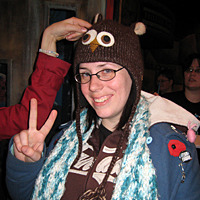 Crystal (2nd year ML, 11th year Wrimo): My brother had stumbled across NaNo too late to participate in 2001, and when the 2002 season rolled around, we both enthusiastically signed up. Neither of us finished that year, but I’ve been an avid devotee ever since, and I’ve finished every since save one.
Crystal (2nd year ML, 11th year Wrimo): My brother had stumbled across NaNo too late to participate in 2001, and when the 2002 season rolled around, we both enthusiastically signed up. Neither of us finished that year, but I’ve been an avid devotee ever since, and I’ve finished every since save one.
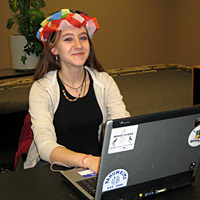 Paige (1st year ML, 8th year Wrimo): To be completely honest, I can’t actually remember how I first heard about NaNoWriMo. Ran across it on the internet somewhere, most likely.
Paige (1st year ML, 8th year Wrimo): To be completely honest, I can’t actually remember how I first heard about NaNoWriMo. Ran across it on the internet somewhere, most likely.
A Guide to the Local Wrimos and Culture — The Edmowrimo Literary Ninjas are a stealthy clan of pen-wielding warriors, sneaking up behind our stories’ backs and dispatching them onto paper with the utmost swiftness.
The general populace has nothing to fear from us literary warriors, our scripting weaponry is wielded only within the realm of the fictional. Above all, we are a fellowship of writers campaigning together under the banner of creative recklessness.
What makes us really stand out is our yearly themes, which are incorporated into every aspect of the experience.
One year we had a Harry Potter/Punctuation theme; we sorted our Wrimos into four houses: Exclamador!, Questeryn?, (Parentheclaw), and Ellipsipuff…. to compete against each other for the House Cup based on event attendance, donations, average words, and number of winners. We had a crest and a fake Latin motto: Novelis Quantitus Maximus, Qualitus Minima.
At TGIO we awarded NEWTs (Noble Event Wrimo Triumphs) for contributions to the Wrimo community and OWLs (Outstanding Writer Levels) for writing achievements, as well as graduation certificates and patches embroidered with the crest to all winners. It was a magical year!
The upcoming year will be medieval-themed if that wasn’t clear from the first couple paragraphs. We also came up with the “NaNoPass”, a motivational punch card that includes goals for the month in speed of writing, volume of writing, event attendance, and community involvement.
The Region In a Nutshell — Never underestimate a literary ninja. Alternately, Home of the Edmowrimo Literary Ninjas: If it ain’t blizzarding, it ain’t Kick-Off.
Check out the region in November!
The NaNoWriMo Edmonton forum
The Edmowrimo website
@edmowrimos
On Facebook
On Youtube
Got a fantastic region? Tell us about it! Have you ever been to a NaNoWriMo write-in?
October 23, 2012
Crowdsourcing My Novel
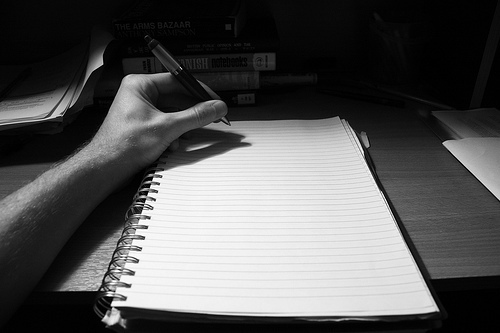
Friends, I am concerned. Usually by this point in October, I have most of an outline knocked out, and a good handle on where my novel is going. I should have at least a dozen chapters summarized, a quick character sketch of at least three of my characters, and a general idea of the structure.
So far this year, I’ve got a page and a half of super basic ideas sketched out and…nothing else.
Now, for many of you, this would not be a big deal at all. But as I have established in the past, I am not a very spontaneous person, and if I don’t have an outline, NaNoWriMo is a complete disaster for me.
This wouldn’t be so stressful if NaNo were a little further away, but let’s face it, November is Coming. So I come to you, Wrimos, to beg your assistance.
Here’s the gist of my novel: after a terrifying and life-altering event sends (main character who needs a freaking name) to therapy, she sets out on a quest to do something every (day? week? month?) that scares her in an attempt to become less neurotic. She is required to keep a journal of these experiences, and decides to start a blog chronicling her adventures.
That’s the general idea. The blog will really help with the structure of the novel, I think (I like a nice structure), and these tasks are a great way for her to meet various secondary characters. I’ve got a few ideas for what happens to her to set her on this path, and I’ll spend some time sorting out the details there. But I need your help with the things she’s going to blog about. What are some things she could do that scare her that would be fun to write about?
And what the heck should I call her?
My November stress levels thank you in advance for your suggestions.
— Sarah
Photo of alarmingly blank page from Flickr user omcoc.
October 22, 2012
DigiWriMo: An Interview with the Founders
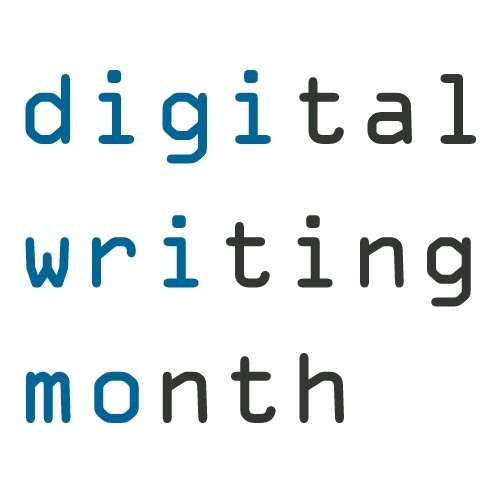
This year, Jesse Stommel and Sean Michael Morris of Marylhurt University conceived of Digital Writing Month to run concurrently with—and complementary to—NaNoWriMo. They are offering DigiWriMo to their students and would-be students, as well as any other writers who wish to join, as a way to acquaint themselves with the oddity and magic of digital writing.
The word-count goal is the same as that of NaNoWriMo, but the delivery of those words is entirely different. Rather than asking people to write novels, they’re encouraging them to create texts of many kinds, all located somehow upon, within, and in relationship with the web.
What inspired you to start Digital Writing Month?
Sean: Digital Writing Month started with a quick phone call from Jesse. He said: “I think we need to do another online course. I think it should be like NaNoWriMo.” I thought he was crazy, and at first, I didn’t see how you could make something like NaNoWriMo happen online.
For starters, there’s nothing like NaNoWriMo anywhere else; and the idea of hosting it like a course online just boggled my mind. Heck, it boggled my mind until even just a couple of days ago!
Jesse: After working on an open online course targeted mostly at teachers and academics (MOOC MOOC), we wanted to create something that was aimed at a much more diverse group of people. Most formal attempts at online learning adhere too much to a very conventional notion of what a class is.
Through our experiments, we’re hoping to find ways to re-imagine what a class is, how it’s shaped, the learning that happens in it, who sits at the head of it, how people interact within it, what the output is, etc. We love the NaNoWriMo format, so we were inspired by what Wrimos concoct every November to make writing fun and experimental.
Digital Writing seems to change the way we write. Do you think it changes the way we read as well?
Sean: I think absolutely. I think there’s a lot more skimming that happens when we read online; but I also think that we learn to scan information for its relevance much more quickly than we do in print. We read for subtext during Twitter exchanges; we read for images on Tumblr and Facebook; and we browse information in a dynamic way that’s never been possible before.
Jesse: I love what Sean says here about skimming. What the Internet lacks in depth it makes up for it by having a good deal more surface. Digital writing harnesses this broad surface by emphasizing collaboration, networks, and communal context.
How, in your opinion, has digital writing affected traditional forms of writing?
Jesse: I hear, like an incessant refrain, this notion that the internet is ruining us as readers and writers—that tools like Twitter and text-messaging are doing irreparable harm to our writing practices, our attention to detail, and (especially) our use of grammar. I believe strongly that we are becoming better readers and writers, because we are doing so much more reading and writing, and because, increasingly, we are doing that work together and for a much larger audience.
Sean: I want to make clear that Digital Writing Month never takes the stand that “print is dead”. Instead, we want to show that digital writing can be an additional creative outlet for the world’s authors.
I’m still very much a fan of paper books, while at the same time, I believe that online writing allows for a kind of energy and synergy that we’re only beginning to understand. I know that digital writing, in what way it can, has shown up in our for-print writing—you see the texts of e-mails, text messages, and more in novels today—but digital writing is a lot more than just the medium upon which its coded, and a lot more than the types of writing we do there.
Digital writing is active, unpredictable, and living in ways that print writing usually isn’t It’s also impermanent, unedited, and sometimes too immediate in ways that print writing doesn’t have to be.
Since digital writing is so intrinsically tied to communication, it seems hard to opt out of digital writing as a genre without opting out of web-based communication entirely. Would you say this is true? And does it create problems for writing in general?
Jesse: To opt out of web-based communication is becoming a rather extreme choice—a choice that has great implications for our personal and professional lives. For example, many people use Facebook as a sort of constant and ever-present family reunion. If I’m not on Facebook, I’m choosing not to show up for the family reunion.
For me, Twitter is like a non-stop professional conference. There is an important conversation happening there, and if I’m absent from that space, I’m missing out on that conversation. The ubiquity of these tools means that we are becoming better and better at creating textual communities for ourselves to inhabit. These tools are also blurring the boundaries between our personal and professional lives.
Sean: I would add only that I don’t believe digital writing is a genre, as we understand genre. There’s something much more unpredictable going on in digital writing. I think it’ll be awhile before we fully understand it the way we do traditional writing.
Do you have any web-writerly influences?
Jesse: I’m a big fan of Kenneth Goldsmith, Traffic or Uncreative Writing: Managing Language in the Digital Age. He manages to make something beautiful of the endless parade of otherwise mundane text we find on the web.
Some of my favorite blogs come from Teo Bishop and Bonnie Stewart. Teo understands how to create conversations on the web. Blogging, for him, is about dialogue—about making himself just “another inquisitive voice in the crowd.” What I admire so much about Bonnie’s work is how layered it is. Her blogs tell stories that reveal themselves over time, very personal stories, which she is both writer and reader of. And even as one of her stories ends, another begins. “I do not like declarations of done-ness,” she writes. “I cannot run out of paper, here.” I actually wept when I first read those lines.
Another of my favorite bits: Pete Rorabaugh writes, “the act of writing is organic and generative.” For him, digital space does not get in the way of organic writing but actually helps cultivate this kind of work. Finally, more than any other writers, I admire my students. Over the years that I’ve been teaching digital composition, these are the authors I’ve come to know best—the authors I’ve connected with most directly. Recently, two of my students, Carrie Padian and Lans Nelson, had work published in a lovely analog book of poetry written in computer code, code {poems}.
Sean, you also mentioned that you are a three-time winner, five-time participant of NaNo. What are your best tips to completing your NaNo novel?
Sean: There came a time when I found myself teaching my last creative writing course. It was a sad thing for me. And so during my very last class session, I wanted to tell these ambitious young writers something that might last, something that might motivate them to keep writing for the rest of their lives.
What I told them was this: “Don’t believe anyone.” Writers are constantly being told that what they do isn’t good enough, that they haven’t written something the “right” way, to the highest fictional standards. A lot of the time, writers give themselves these messages. And I say, don’t believe them. Don’t believe you’re not good enough. Don’t believe you’re not doing it right. Don’t believe you need to start over and begin again. And certainly don’t believe that you shouldn’t be writing.
When I’ve done NaNoWriMo, I’ve written some very interesting stuff, some I probably wouldn’t share, but that I’m very proud of anyway. Some of that writing is brilliant. Some of it is clearly experimental. But all of it is writing and all of it is worthwhile. As a NaNo novelist sitting down to the page every day, I reminded myself not to listen to all the voices of doubt and indecision and criticism, and to just write. Write because I love to write, because for an hour a day I could afford to give myself something wonderful, self-indulgent, and hopeful.
Jesse: NaNoWriMo teaches writers something very important about practice, about how to make writing an integral part of the day, and how to build an attention to that work into everything else we do. It also makes writing a communal act, creating a space for Sean and I to converse about writing practice across discipline and genre.
We’re curious to know how homework amnesty for NaNoWriMo participants in your creative writing courses played out. It sounds like a great incentive!
Sean: Yes. One year, I offered my Intro to Creative Writing students the opportunity to participate in NaNoWriMo in lieu of their regularly-scheduled homework. Students, of course, love the idea of homework amnesty; but the truth is, a lot of my students who chose the NaNoWriMo option for November ended up asking for the regular homework. NaNoWriMo was more challenging than other college assignments! NaNoWriMo is pretty intense homework, especially for college students who, early in December, faced final exams and final papers.
For those who did take up the challenge, though, I held a couple of class days that were simply “write-ins”, where we all sat around together, ate donuts, and wrote. During class, we talked about the problems they were having with pacing, characterization, rising action, etc. Writing a novel is bigger work than most creative writing classes call for, and so our time in class reflected writerly work on a much larger scale.
I followed my students progress on the NaNoWriMo site, too, and kept up with their word counts. Those who completed their novels just had to show me their NaNoWriMo winners certificate to receive credit for their work that month. By the time November 30th rolled around, all the NaNo novelists had learned something they never thought they’d learn in college, and not just about writing! They learned they had the stamina and creativity (and insanity) to see through to the end a really unique, large-scale project.
So, to get back to your first question about why we’re undertaking Digital Writing Month, I guess you could say we want to give writers a massive sort of homework amnesty, a free and open space to explore their writing. We’ve upped the ante a little by putting the whole thing in a digital context, but we’re sure there are plenty of folks up to the challenge.
Jesse Stommel is the Director of the Marylhurst University English and Digital Humanities degree program, the home of Digital Writing Month. He is also the co-founder and managing editor for Hybrid Pedagogy, an online journal of teaching and technology.
Sean Michael Morris is the Director of Educational Outreach for Hybrid Pedagogy, and a part-time faculty member with Marylhurst’s English and Digital Humanities degree program. He’s also a three-time NaNoWriMo winner, a former creative writing teacher, and the “Head Hare-brain” behind Digital Writing Month.
October 19, 2012
Who Are You, and What Do You Write?
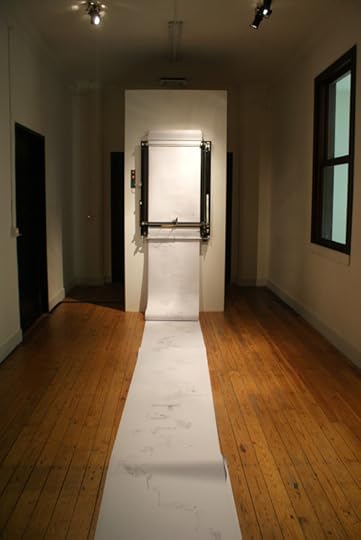
Here at NaNoWriMo, we believe in writing in all its forms—all the better if it’s available for the world to see. That’s the same idea being celebrated during tomorrow’s National Day on Writing. Writers around the world are encouraged to share their scribblings (of any sort) with the hashtag #WhatIWrite today.
Tell a new acquaintance that you’re a writer, and the immediate follow-up is typically “Oh, what do you write?” (Occasionally, you get sympathy eyes, and then a swift change in subject. This is sometimes a relief.)
It’s a tough question to answer, in part because it’s vague. They could be wondering whether you’re a journalist, or a novelist, or a conspiracy theorist who scratches out plots in a little black book wrapped in tin foil. They could be wondering if you write short stories, or science fiction, or epic poetry. They could be making awkward first-date talk and desperately hoping you won’t go into too much detail about the fictional planet you’ve created for your space opera. It’s hard to know.
The truth is that it’s a question that asks you to bare your creative soul, that can have deep roots in the history of your life. Reflecting on what you write isn’t so different from reflecting on who you are.
There might be moments where you read short stories your mom wrote as a student, and realize, ‘Hey, that habit of writing the same thing redundantly in three consecutive, only-slightly-different sentences is something she did, too.” You might realize that your voice when you write in your native language is different from the one you use when you’re writing in another. That every novel you’ve ever written has a character from Arizona who was raised by a single dad, and who turns out to be a whiz with a soldering iron and nunchakus.
The actual process of writing and publishing a novel can be a marathon. Rewrites are involved, editorial voices, concerns about market-trends. But the novels you write every November, riddled with plot holes, grammatical errors, and character inconsistencies as they might be, are a pure distillation of who you are as a writer in that moment. It’s the stuff you write at four in the morning when you know you should go to bed but the idea-monster in your head is champing at the bit, red-eyed and furious for more; more writing!
It’s your authorial voice when your outlines suddenly bottom out and you go on for a page and a half typing things like, “And then they all died unspeakable deaths because they had no idea how to stop the suddenly-sped-up expansion of the universe without resorting to a deus ex machina. Pretty sad stuff. Lots of people cried.”
The ideas that inspire your 2012 novel are this year’s ideas. The ones that inspired your 2009 novel, were those of your three-years-ago self. Even if publishing isn’t right for you, your manuscripts aren’t just novels, they’re time capsules.
People know you through your stories. You come home and tell your loved one about your day. You go to work in the morning and tell your co-workers about what you did over the weekend. You write status updates, and tweets; post GIF collections on Tumblr, and pick the perfect Instagram filter for that photo of you chomping into the biggest burger known to man. We define ourselves by our stories, whether we tell them through words or pictures.
You happen to do it, once a year, in a novel. What are you writing this year?
Photo by Flickr user Marc Wathieu.
October 18, 2012
Hidden NaNoWriMo Resources at your Local Library

While most writers won’t have time in November for in-depth research, the library is still a crucial destination for early planners, or for any Wrimo who’s motivated by a book-charged environment. The obvious must-have is Chris Baty’s classic No Plot? No Problem!, although libraries have other books about writing fiction (generally shelved in the 808 section if you are using the Dewey Decimal System).
But besides fiction technique books, is your library promoting all of the writing resources it has for its local budding novelists? Check out these “hidden” writing resources:
Grab a few Fiction Books in the genre you are writing, for reference and inspiration. YA’ers, meet Maureen Johnson. Fantasy writers, cozy up to Brandon Sanderson.
Browse through the same Non-Fiction Books your character might! It’s a great way to get a quick sense of something about your character’s interests (Kayaking? Hobbyist robotics? Making cake pops? Living with fibromyalgia? Preschool teacher resources?)
Check out Movies and Music to find inspiration from classic movie storylines, the stirring soundtrack of your action scene, or the sappy love song that your characters will always remember from the night they met.
Look up specific back issues of archived magazines and newspapers on microfilm for a historical novel. Get a quick glimpse to inspire you in November, and then return to the library later while you’re editing to research and fact-check your descriptions.
Need a character name? Baby Name Books provide first names and Genealogy resources are great for surnames.
Need to know about your character’s career choice? In the US, the Occupational Outlook Handbook sums it up nicely (and it’s also online).
Don’t forget the physical space. Even if you’re not a planner, during November your library may offer:
Come Write In space: write uninterrupted on your own laptop.
Free Wi-Fi is usually available. Although you might want to wait to connect until after you reach your word count for the day.
If you need a computer, most libraries provide public computers. In fact, Gennifer Albin, the author of Crewel , wrote her novel during NaNoWriMo on a library computer. There is nothing like a time limit to help you write faster!
People watching. Need I say more.
Here at the Topeka and Shawnee County Public Library, we have been expanding our NaNoWriMo programs each year since 2004. Besides an October kickoff, which we call “How to Write a Novel in 30 Days” we now offer two early-October workshops on pre-writing and on plotting, scenes and dialogue.
We also have a few Sunday afternoon write-ins, which have gradually moved from the public computer lab to a bring-your-own-laptop meeting-room setting. And our participants meet for a few mid-week Wednesdays at a coffee shop in town to “Caffeinate and Chat” informally.
This year, to encourage other librarians to partner with NaNoWriMo, I also put our handouts online and recorded a free 20-minute webinar for librarians who are considering offering NaNoWriMo programs.
Our library also sponsored a Community Novel Project this year, in which 20 local fiction authors, most unpublished, each contributed a chapter to advance an adventure story, which the library then published. We worked on a tight deadline, and Capital City Capers was published in September, because I knew that the NaNoWriMo writers who participated all had other priorities in November!
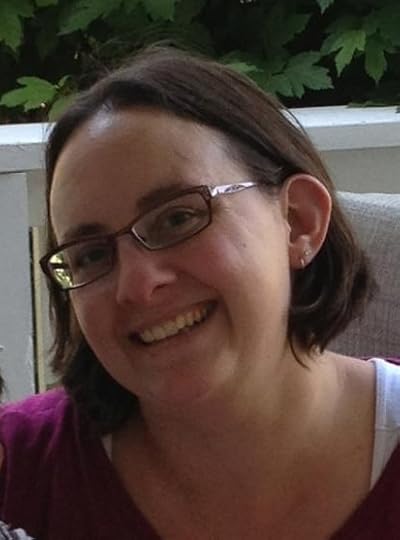 Lissa Staley is a contributing author and editor of Capital City Capers, a serialized, twenty-author Community Novel Project. She is a Book Evangelist and Librarian at the Topeka and Shawnee County Public Library, the ML for Topeka, Kansas, and a nine time NaNoWriMo winner. November is her favorite time of year.
Lissa Staley is a contributing author and editor of Capital City Capers, a serialized, twenty-author Community Novel Project. She is a Book Evangelist and Librarian at the Topeka and Shawnee County Public Library, the ML for Topeka, Kansas, and a nine time NaNoWriMo winner. November is her favorite time of year.
Do you ever work in your library for NaNoWriMo? Any pro-tips that you’ve gleaned?
October 17, 2012
An Artist’s Date with Julia Cameron
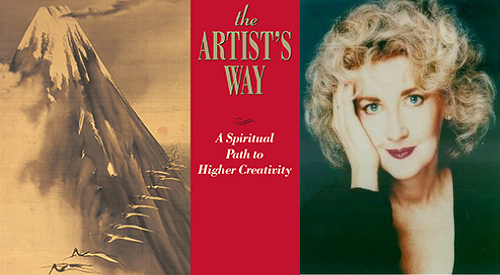
Julia Cameron was a successful screenwriter by her late twenties, but she realized she was writing with the pains of her ego instead of the lightness of her soul. She went through a process of “creative recovery” that she’s now shared with millions of people through such books as The Artist’s Way and her website Julia Cameron Live .
Cameron’s approach to writing mirrors NaNoWriMo’s framework in many ways. She discusses banishing “the Censor,” jumping into the mess of writing instead of honoring the judgments of perfectionism, and inviting in creative whimsy to nurture the artist’s soul. We interviewed her for some ideas on how to get the creative juices flowing before NaNoWriMo. For more NaNo Prep ideas, you can track #nanoprep on Twitter, read the NaNo Prep tag on this blog, and visit our site here.
Tell us about your writing career. How did you decide to become a writer, and where has it led you?
I have always been a writer. I started in sixth grade, writing a story to woo classmate Peter Mundy. By the time I was eighteen, I was writing regularly. I wrote in many different genres—short stories, novels, poetry, and journalism—I wrote anything and everything.
You’ve worked with a lot of people in your workshops. What’s the most frequent creative problem people have?
I believe people have difficulty starting on projects. Morning Pages help them to stop procrastinating. They miniaturize their “Censor” and allow them to work more freely.
What are “morning pages”?
Morning Pages are three pages of longhand morning writing. They are strictly stream-of-consciousness—there is no wrong way to do them. Because of this, they miniaturize the Censor, allowing you to move more freely to the page.
It’s as if you are building a spiritual radio kit. With Morning Pages, you are “sending”—notifying the Universe of what you like and what you dislike. Morning Pages provoke, clarify, comfort, cajole, prioritize, and synchronize the day at hand. They help you to discover artistic confidence and productivity.
Why not evening pages?
If you write pages in the evening, you are reviewing a day that you are powerless to change. Morning Pages lay out a sort of golden track for your day. They keep you from being hijacked by other people’s agendas.
Miniaturizing your Censor is akin to our notion of banishing your “inner editor.” Why do you think a willingness to do something badly is a good starting point for creators?
When we are willing to write “badly,” it frees us to write at all. Taking an attitude of experimentation banishes the perfectionist.
Can you tell us about your own creative recovery?
Up until age twenty-nine, I wrote from ego. At twenty-nine, I got sober and realized I needed a new way to write. I tried letting a Higher Power “write through me”—I listened and wrote what I heard. My writing improved dramatically. I came to believe that writing was a spiritual practice.
The notion of the tortured artist is so prevalent in our culture, but you view the artist as a compassionate, loving being. Why is your take different?
I believe our society has a toxic view of artists. We believe artists are drunk, crazy, broke, irresponsible, loners, promiscuous, doomed, unhappy, born, not made. I believe something quite different. I believe artists can be sober, sane, solvent, responsible, user-friendly, faithful, saved, happy, discovered, and recovered.
You advise people to go on weekly “artist’s dates”—time to nurture one’s creative consciousness. What are some of your favorite artist’s dates?
I now live in Santa Fe, where we have something called Canyon Road. It harbors more than a hundred galleries. They are provocative. When I lived in New York, my favorite Artist Date was a visit to the American Museum of Natural History. There, they had dioramas. These featured animals in their natural habitats. I loved them.
Do you have a favorite writing beverage?
I drink cold coffee.
Have you ever participated in National Novel Writing Month?
I’ve never participated in National Novel Writing Month, but I have written a novel in a month. I wrote my novel Mozart’s Ghost while on book tour.
Have you ever written a story about an animal that talked? A pirate? A dragon?
No. All of these remain to be explored.
What is the one tip you would give to first-time NaNo novelists?
Try writing Morning Pages.
Have any of you tried writing first thing in the morning? What is your typical writing schedule?
Chris Baty's Blog
- Chris Baty's profile
- 63 followers



